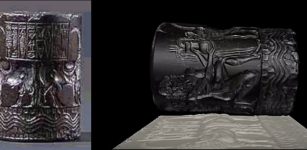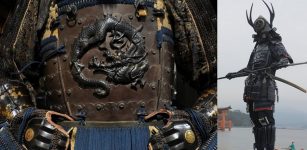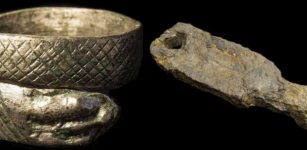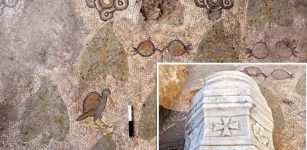Jolly Roger – Symbol Of Golden Age Piracy
A. Sutherland - AncientPages.com - One of the first associations that come to mind when we think about pirates is Jolly Roger, the black flag decorated with white skull and crossbones – the intent with a clear meaning – fear and intimidation.
Capture of the Pirate, Blackbeard, 1718, Jean Leon Gerome Ferris, painted in 1920 and the pirate’s flag.
Flags on ships played an important role; they allowed identifying whether a ship on the horizon was hostile or allied.
“Jolly Roger” was a common name for the famous symbol of European and American pirates and was always a hostile signal flag.
Pirate ships traditionally raised a solid black flag to identify themselves as pirates sending the message that if the ship put up no resistance, everyone on board would be given mercy.
If the ship chose to put up a fight, the black flag was replaced with a red flag, which sent the message that absolutely no mercy would be given. The color red in pirate flags symbolized bloodshed and the early pirates sailed under the Red Flags.
Both flags - a kind of psychological warfare - were intended to demonstrate the mighty power and fearlessness of the approaching pirate ship and to terrify.
Both colors had symbolic significance.
The origin of the name is not entirely clear. Some theories suggest that the flag took the name of "Old Roger" - the nickname, which was determined, by the devil, or "Roger" - the term for drifters, losers, and vagabonds.
Many historians believe that the term “Jolly Roger” dates further back in history, namely to the 13th century, when the image of a skull and crossbones was used by the Knights Templar and then adopted by the Knights of Malta who were known for their acts of piracy.
One popular theory (without any documented evidence) says the “Jolly Roger” name derives from the French "joli rouge" (pretty red) color of the flags used by pirates first.
The designs of the pirate flags varied much.
Red Sea raider Henry Every (or Avery) is reckoned by some to be the most successful pirate who ever lived.
While many pirates still continued to use plain black or red flags, some captains began to elaborate the flags’ design with symbols representing violence and death; some designs were associated with the captain’s reputation or presented messages and warnings addressed to his enemies.
For instance, John Rackham (widely known as “Calico Jack”, English pirate captain operating in the Bahamas and in Cuba during the early 18th century had a flag with a white skull over crossed swords on a black background, that became synonymous with the Golden Age pirate ships.
Henry Every’s flag was black and decorated with a white image of a bandana-wearing skull in profile over crossbones.
Blackbeard (Edward Teach or Thatch), a notorious English pirate who operated around the West Indies and the eastern coast of Britain's North American colonies, had a black flag with a white image of a horned skeleton holding an hourglass in one hand and spearing a red heart with the other.
This image was clearly meant to strike fear into the hearts of everyone he approached as the hourglass sent the message that time was running out and the speared heart suggested he would show no mercy.
Written by – A. Sutherland - AncientPages.com Senior Staff Writer
Copyright © AncientPages.com All rights reserved. This material may not be published, broadcast, rewritten or redistributed in whole or part without the express written permission of AncientPages.com
More From Ancient Pages
-
 On This Day In History: Vlad III Dracula Regained Throne Of Wallachia For The Third Time – On Nov 26, 1476
News | Nov 26, 2016
On This Day In History: Vlad III Dracula Regained Throne Of Wallachia For The Third Time – On Nov 26, 1476
News | Nov 26, 2016 -
 Strange Case Of The ‘Impossible’ Glove Remains Unexplained – The Discovery – Part 1
Featured Stories | May 24, 2019
Strange Case Of The ‘Impossible’ Glove Remains Unexplained – The Discovery – Part 1
Featured Stories | May 24, 2019 -
 Reconstructed Roman Gateway Tells The Story Of Britain’s Invasion
Featured Stories | Aug 26, 2023
Reconstructed Roman Gateway Tells The Story Of Britain’s Invasion
Featured Stories | Aug 26, 2023 -
 When And What Was The Golden Age Of Piracy?
Ancient History Facts | Jul 25, 2016
When And What Was The Golden Age Of Piracy?
Ancient History Facts | Jul 25, 2016 -
 Sharkalishharri Cylinder Seal From The Fifth King Akkad Dynasty
Artifacts | Feb 14, 2016
Sharkalishharri Cylinder Seal From The Fifth King Akkad Dynasty
Artifacts | Feb 14, 2016 -
 Baffling Cathar Mystery – Was It A Double Ancient Reincarnation Case?
Featured Stories | Jan 12, 2025
Baffling Cathar Mystery – Was It A Double Ancient Reincarnation Case?
Featured Stories | Jan 12, 2025 -
 Celtiberians: Intriguing Martial Culture And Their Skilled Warrior Infantry
Civilizations | Jul 13, 2024
Celtiberians: Intriguing Martial Culture And Their Skilled Warrior Infantry
Civilizations | Jul 13, 2024 -
 Crosby-Schøyen Codex: Ancient Coptic Manuscript Reveals Sermon That Spurred Violence Against Jews
Featured Stories | Jun 5, 2024
Crosby-Schøyen Codex: Ancient Coptic Manuscript Reveals Sermon That Spurred Violence Against Jews
Featured Stories | Jun 5, 2024 -
 Ancient History Of The Samurai Armor
Featured Stories | Aug 27, 2018
Ancient History Of The Samurai Armor
Featured Stories | Aug 27, 2018 -
 Discovery Of Roman Settlement, Workshops And Artifacts Will Shed Light On Their Life In Northern England
Archaeology | Apr 13, 2017
Discovery Of Roman Settlement, Workshops And Artifacts Will Shed Light On Their Life In Northern England
Archaeology | Apr 13, 2017 -
 Ancient Human Feeding Behavior Studied By Scientists
Archaeology | Jan 18, 2022
Ancient Human Feeding Behavior Studied By Scientists
Archaeology | Jan 18, 2022 -
 At Least 20 Ancient Colored Wooden Coffins Discovered In Asasif Necropolis, Luxor
Archaeology | Oct 15, 2019
At Least 20 Ancient Colored Wooden Coffins Discovered In Asasif Necropolis, Luxor
Archaeology | Oct 15, 2019 -
 Extraordinary Ancient Mosaics, Crucifixes, And Long-Lost Church Discovered In The Holy Land
Archaeology | Dec 22, 2017
Extraordinary Ancient Mosaics, Crucifixes, And Long-Lost Church Discovered In The Holy Land
Archaeology | Dec 22, 2017 -
 Freya – Vanadis: Beautiful Desirable Goddess And Her Brisingamen Necklace In Norse Mythology
Featured Stories | Jan 21, 2018
Freya – Vanadis: Beautiful Desirable Goddess And Her Brisingamen Necklace In Norse Mythology
Featured Stories | Jan 21, 2018 -
 Search For Noah’s Ark Continues – The ‘Inside Mount Ararat’ Research Project
Featured Stories | May 4, 2014
Search For Noah’s Ark Continues – The ‘Inside Mount Ararat’ Research Project
Featured Stories | May 4, 2014 -
 Who Is Secretly Keeping A Watching Eye On Tibetan Monasteries?
Featured Stories | May 14, 2019
Who Is Secretly Keeping A Watching Eye On Tibetan Monasteries?
Featured Stories | May 14, 2019 -
 Patara Lighthouse Built By Emperor Nero In 64 AD Will Shine Again
Archaeology | Mar 5, 2020
Patara Lighthouse Built By Emperor Nero In 64 AD Will Shine Again
Archaeology | Mar 5, 2020 -
 Hopi’s Encounter With Maasaw – The Skeleton Man And His Gift Of Sacred Knowledge
Myths & Legends | May 5, 2017
Hopi’s Encounter With Maasaw – The Skeleton Man And His Gift Of Sacred Knowledge
Myths & Legends | May 5, 2017 -
 Iktomi – Native American Spider-Trickster Spirit Whose Stories Teach Moral Values
Featured Stories | Jan 28, 2019
Iktomi – Native American Spider-Trickster Spirit Whose Stories Teach Moral Values
Featured Stories | Jan 28, 2019 -
 Mikoshi-Nyudo: Evil, Bald-Headed And Long-Necked Yokai Goblin In Japanese Folklore
Featured Stories | Sep 12, 2024
Mikoshi-Nyudo: Evil, Bald-Headed And Long-Necked Yokai Goblin In Japanese Folklore
Featured Stories | Sep 12, 2024



